Hartwell85
Member
After watching one of the workshops at the 2021 AAW Virtual Symposium, I adopted the devices that other wood turners used for supporting a work light and dust collector to my mini-lathe. The dust collector arm consists of three pieces of wood 3/4" thick by 1.5" wide. The assembly is mounted to a 1" diameter dowel and clamped in place with a split joint on one of the arms. The hinge joints on the middle piece are joined by a 1/4"-20 carriage bolt, rubber washer between the pieces, and a 1/4"-20 lock nut on top. The lock nut keeps the joint from loosening when I adjust the dust collector. The lock nut is tightened just enough the allow the joint to flex but still remain where set. The rubber washer provides resistance to help the joints stay where set. The dust collector attachment is held in place by a 2x4 with a cut-out that clamps over the hose fitting. This design is a significant improvement over the cumbersome dust collector I was using.
The work light bracket is made from a piece of of wood 3/4" thick by 1.5" wide. A fender washer matching the magnetic base of the work light is attached at one end with a screw through a counter sunk hole in the washer. The bracket attaches to the lathe ways using 1/4"-20 carriage bolt, a thick fender washer, wood spacer to center the bolt, and 1/4"-20 finger knob. The only drawback is that the knob and bolt interfere with installation of my Nova chuck.
The work light bracket is made from a piece of of wood 3/4" thick by 1.5" wide. A fender washer matching the magnetic base of the work light is attached at one end with a screw through a counter sunk hole in the washer. The bracket attaches to the lathe ways using 1/4"-20 carriage bolt, a thick fender washer, wood spacer to center the bolt, and 1/4"-20 finger knob. The only drawback is that the knob and bolt interfere with installation of my Nova chuck.
Attachments
-
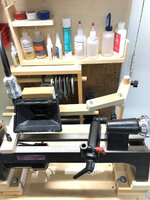 7B4F5D9C-82AB-40AF-9528-6C2FF4B8B090_1_201_a.jpeg343 KB · Views: 274
7B4F5D9C-82AB-40AF-9528-6C2FF4B8B090_1_201_a.jpeg343 KB · Views: 274 -
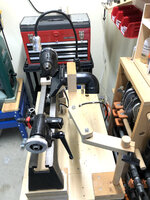 A85E478A-E7A9-4953-86A5-CDDBDE639FCF_1_201_a.jpeg379.2 KB · Views: 299
A85E478A-E7A9-4953-86A5-CDDBDE639FCF_1_201_a.jpeg379.2 KB · Views: 299 -
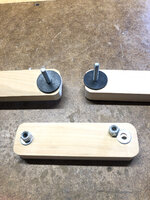 E6FC4398-9E32-4E1C-924B-B0A1437C5162_1_201_a.jpeg476.2 KB · Views: 285
E6FC4398-9E32-4E1C-924B-B0A1437C5162_1_201_a.jpeg476.2 KB · Views: 285 -
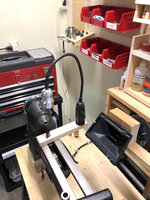 DA9A50AA-DA93-4B12-B716-D2477FDD68FF_1_201_a.jpeg369.6 KB · Views: 261
DA9A50AA-DA93-4B12-B716-D2477FDD68FF_1_201_a.jpeg369.6 KB · Views: 261 -
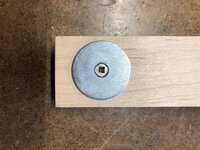 747B26C7-6B49-44B5-8BC9-8B2396E4CCA0.jpeg413.5 KB · Views: 284
747B26C7-6B49-44B5-8BC9-8B2396E4CCA0.jpeg413.5 KB · Views: 284 -
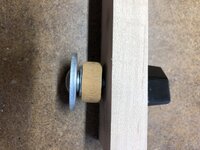 4C8CE6F4-1CE1-47DD-BBA0-2A0B60DF9145.jpeg286.6 KB · Views: 308
4C8CE6F4-1CE1-47DD-BBA0-2A0B60DF9145.jpeg286.6 KB · Views: 308
